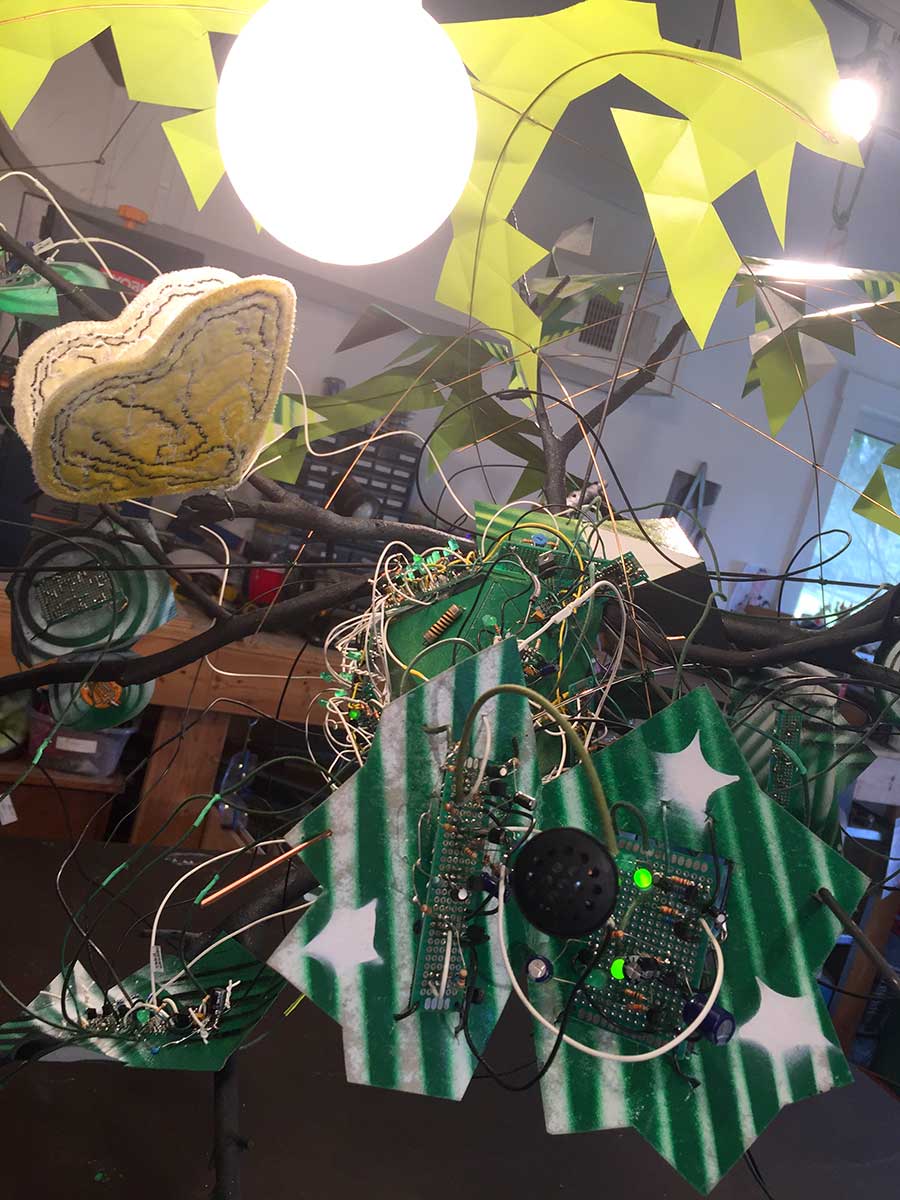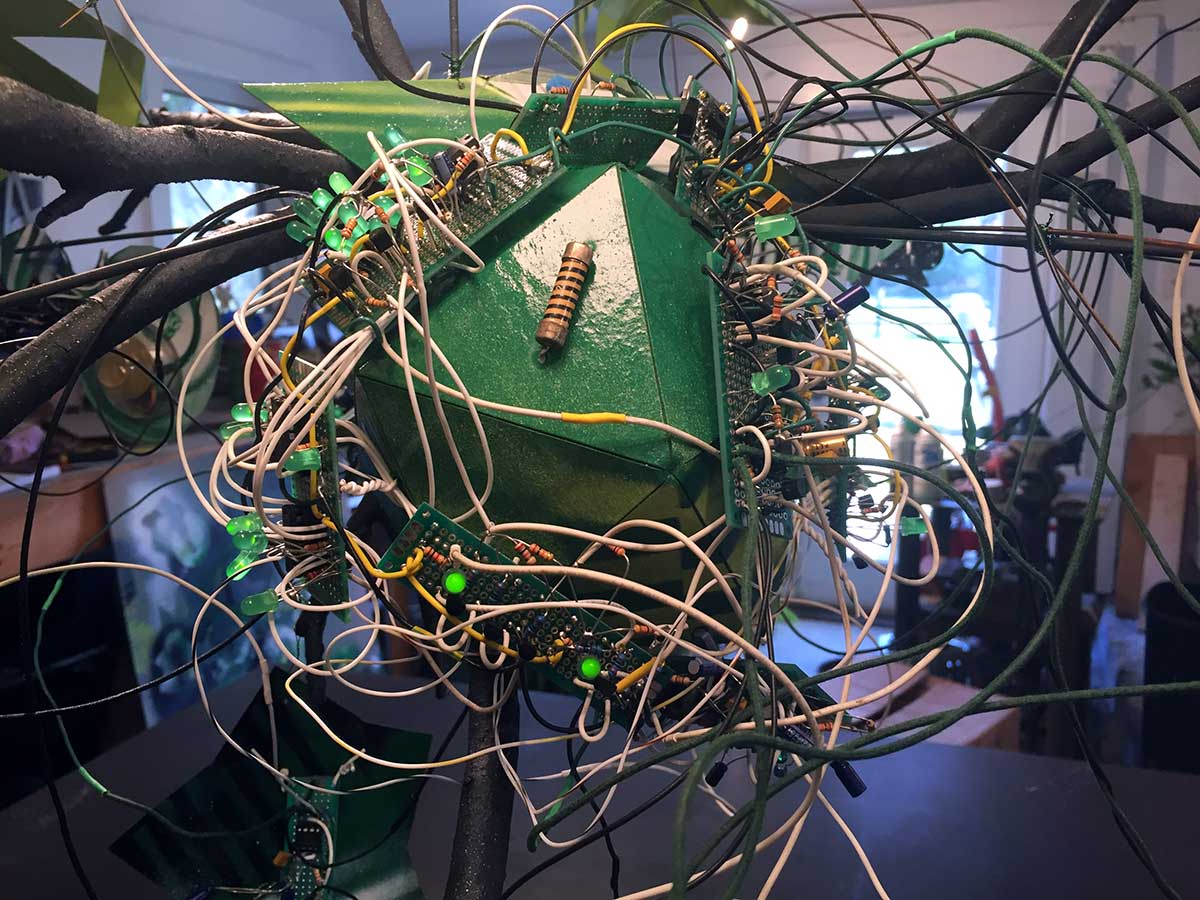I am pleased to reveal my latest commissioned piece, “Sounds of Another Time (Rising Dragon),” 2021. This sound-generating work of art fuses several themes: new and old symbols, rising and falling cultures, electronic and traditional media, and feminist electrical engineering. The piece is made with functioning and non-functioning circuit boards, celebrating the expressive potential of electronic hardware as an artistic medium, and specifically highlighting the naturalistic, decorative form that electronics can take. The circuit boards are fiberglass with etched copper, some plated in solder or gold, to which I have selectively applied various chemical patinas in the style of Louis Comfort Tiffany. Because fiberglass is translucent, I am able to backlight the central dragon and cast shadow on Venus reclining with her cherubic cohorts. The silver-colored circuits on either side of the dragon (copied from an illustrated winged griffin by Alexis Peyrotte, 18th century) are abstract electronic Foo dogs that have been overprinted with floral vines in the style of Zuber. East rises above the West. Blinking LEDs on the Foo dogs evoke fireflies and are, in fact, powered by the (hidden) analog electronics that generate this cricket soundscape. There are two knobs, one of which controls the dragon’s growling voice and a second changes the chirp rate of a single cricket (to show the dynamic nature of the analog electronics). I plan to wire one piece from this series with additional knobs that control the entire soundscape in greater detail. The art can be enjoyed with or without electricity (and has the option to turn on backlighting only, without sound).
Soon, I will post images of other available works from this series (message me with inquiries) which have subtle variance in color due to different patinas on the metal. This specific piece is destined for a private collector in Washington, DC. Thank you to Felix Etienne-Edouard Pfeifle for orchestrating this amazing commission!
”Sounds of Another Time (Rising Dragon)",” 2021. Analog electronics, printed circuit boards, and silkscreen on fabric-covered panel. Unique series of 6 mixed media electronic artworks with one AP. 23.5” x 37.5 x 2"
soundscape
Studio soundscape /
Two Cricket Tableaux /
Two Cricket Tableaux (artist proofs 1 of 3), 2020. Archival inkjet print, printed circuit boards, and analog electronics on panel with artist-made frame. 8” x 10” x 2”
Electrolier (September night in Virginia) /
I've been working around the clock to finish my Hackaday Prize application and pack for Hacking Nature's Musicians in Mexico. As closure for my recent chapter, the various circuits that I've shown you over the past few weeks have migrated from my bench and into a sculpture titled "Electrolier (September night in Virginia)," 2018. Here is an informal video:
The video quality isn't great... (shot with my iPhone under bad lighting and extremely messy studio)... but hopefully you get the idea. The sculpture contains one instance of my Mother Nature board design, recognizable by the dense tangle of white wires connecting logic gates, and six sound generating "animal circuits" each with its own speaker. The colorful graphics are spray painted cardboard, and everything is hung on a tree structure under a moon (globe pendant bulb). Oh, and that large moth is made out of silk velvet that I dyed and embroidered with an old industrial "Ultramatic" machine. I would have used small molex-style connectors to connect everything, but there was no time.
It's interesting that so many long wires didn't screw up my signals. I credit this to my use of common emitter amplifiers to buffer the signals, and the fact that I'm not drawing much current for anything you see (or hear). The whole sculpture is powered with a 12VDC / 1.5 amp power supply. I also used multiple 0.1 uF ceramic capacitors between power and ground on most of the individual perfboards. It's critical to remember power-ground capacitors when you're dealing with a lot of amplified signals banging on your power rails. I'm careful to avoid really small gauge wire, and I add many pathways to ground ("let ground abound.")
So... now I am packing my electronics bench into a suitcase and praying that security does not detain me at the airport. I'm throwing in packets of desiccant and crossing my fingers that jungle humidity doesn't zap everything. Making analog electronic circuits in the jungle will be interesting to say the least -- stay tuned for the sounds of los músicos de la naturaleza en Quintana Roo!
Mother Nature in perfboard /
I've been busy migrating my "Mother Nature" controller circuit out of my breadboard and into perfboard... and yes, it's insane but no, I don't have time to produce a printed circuit board because I'm leaving in six days for a fellowship in Mexico. For the record, I do not recommend soldering so many components and connections in perfboard because the risk of error is high, either from bad solder joints, signal interference, or just plain confusion. I plan to design a printed circuit board for future embodiments of Mother Nature. Stay tuned.
As you can see in my previous log, I'm surrounding my perfboard circuits with spray painted cardboard to make them look cool -- and by the way, you could use this quick-and-dirty strategy to make a "starving artist's badge" for the Hackday Superconference.
As for the design of my "Mother Nature Board," aka random pulse generator to trigger various events, I have some additional technical tips to share:
Don't have logic ICs on hand? Build discrete transistor gates. This approach has the advantage of common components (NPN transistors, resistors, diodes) and you can add multiple inputs to the same gate -- which is useful if you discover that an event is triggering too often... just add another input to the gate and the outcome will become less frequent. Not triggering often enough? Remove or change an input to the gate. You can even tie an input to ground (or power) and let the other fluctuate. I use 2N3904 transistors for as many things as possible, but you could also build these cool light gates described by @Dr. Cockroach
There's a limit to how many things you can drive directly with a signal such as the output of a logic gate. Good engineers read data sheets and calculate voltages and current at various locations in their circuit. Impatient engineers add a generic common emitter amplifier between the signal OUT from a logic device and the signal IN to whatever you're driving. This hand-waving approach to buffering will not work in all cases! But it will probably work for most slow logic applications where you want to transform a signal multiple times and drive some light loads. I'm an artist who prefers prototyping to math, so I work a lot with "try it and see" circuit design. Plus, I am not building a nuclear reactor. Note that a common emitter amplifier will invert your signal. Pay attention to whether you need your signal to be active high or active low. Note that a 555 timer in monostable aka one-shot configuration is looking for an active low input. If necessary, invert the signal again to get what you need.
Mosfets make great electrical "on/off" switches because they don't draw current on their gate (==the mosfet equivalent of a transistor's base). They just need a voltage. I use mosfets for the last step in my Mother Nature circuit, or the point at which I want to turn power on or off to a particular sound circuit (the load). Make sure you have a gate resistor to ground or voltage will "sit" on the gate even when the signal is low (and the mosfet won't turn off).
I hope these tips are helpful. To end this log, I give you a video showing my Mother Nature circuit in perfboard with two sound circuits hooked up. If you watch the LEDs carefully, you will see how certain combinations of logic are triggering the sound circuits. The cricket is wired up to chirp most of the time, whereas the Katydid is triggered less frequently. For this demo, I hooked up only two sound circuits because it's already hard to understand what is happening, and more circuits becomes a sort of natural chaos... which is my goal, as you will see in forthcoming logs.
Same signal, many sounds /
I've been migrating my circuits out of the breadboard and into soldered form. I'm also hooking up speakers so that my sound generating circuits are ready for installation in a sculpture of Virginia's nocturnal ecosystem. Because most of my circuits use a custom piezo electric speaker (built with my own amplifier board), I have to install each piezo element into a physical housing... and there's some interesting "play" here. One electronic signal can generate many different sounds depending upon the speaker's physical design. Here's a video of me testing various installations of a piezo element for an insect that makes a steady background noise.
It's cool to experiment with the interface between electrical signal and material properties. It's also critical to get it right, or else the piezo element will make a horrible rattling or screeching. Even a tiny drop of glue (to fix the piezo element in place) will alter the sound quality --usually the pitch-- and superglue can sound different from rubber cement or hot glue or tape. All of this is no news to a human musician, who knows that a note ill-played (even slightly) is a fail, and teensy subtleties often make the difference between average sound quality and genius.
It is interesting to wonder what makes animals of the same species sound different in nature: is it their electrical impulse or their physical form? (Is it their schematic, their CAD file, or their bill of materials?) Members of the same species inherit the same circuit design as well as physique. External physical factors, such as climate, have some degree of influence over material properties of the body --for example, a dehydrated cricket sounds differently than the same cricket wet with rain; a fat frog sings a different tune than the same frog skinny; and so on and so forth. We also know that "animal circuits" are sensitive to electromagnetic fields, and capacitive coupling undoubtedly affects individuals in close proximity. I suspect that physical factors play a greater role in the variability of an individual's song if but for no other reason because birds sound the same whether they are sitting on a tree branch or an electrical transformer (at least, I think they do). PS: Eventually I will tackle the challenge of bird song, but their vocal complexity requires more computation... which is why I have started with insects.
To end this log, I leave you with one more video clip of my "background noise" insect. Here it is with a plastic spool installed over the piezo (now painted green, black, and white). The soldered perfboard is embedded in a cardboard cutout that is painted to look like a forest creature sounds. Soon, this mixed media object will be joined with other embellished animal circuits to build a vignette of nocturnal musicians.
August insects /
Landscape painting and analog electronic soundscape (detail of work in-progress). August 2018
I create the sound of a buzzy August insect using a 555 timer to drive a transistor astable multivibrator (to give timbre). Another slow astable multivibrator provides pulse input to a 555 timer in monostable configuration, that gives a pulse out to the base resistor of an astable multivibrator that sets the tempo. That's why the insect rattles for awhile and then stops (monostable 555 goes high - the rattle tempo is active low).

















